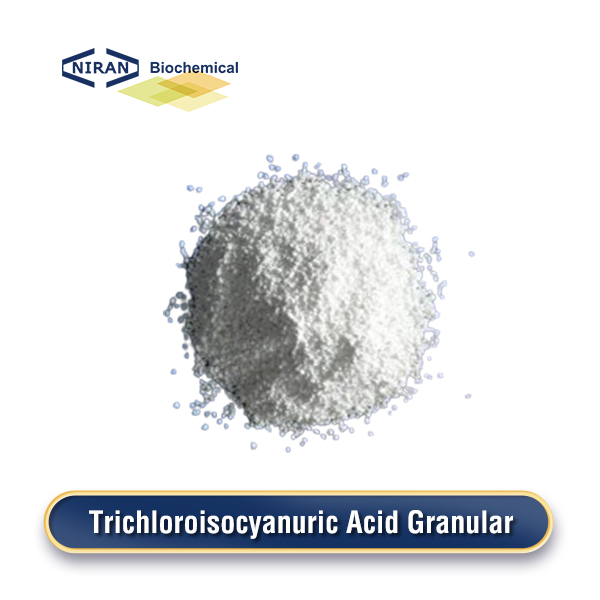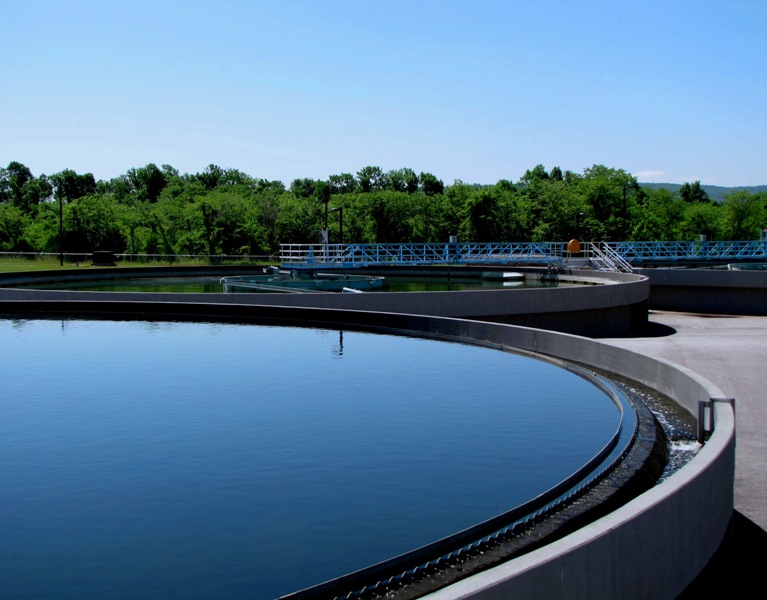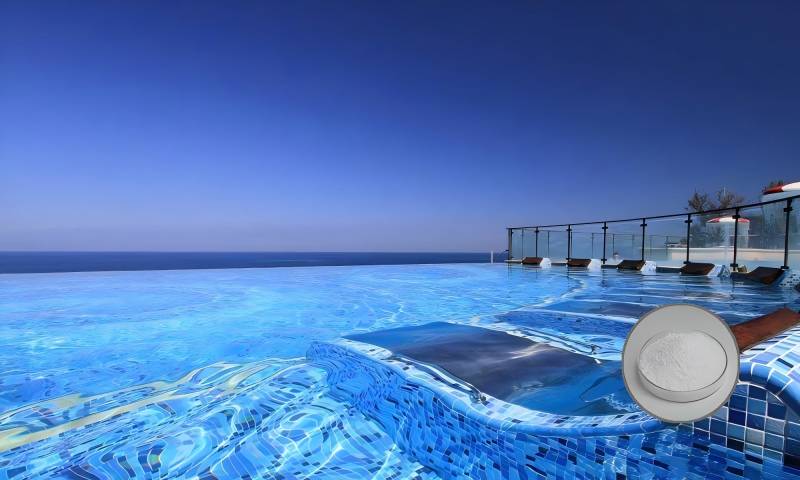One common chlorine-based substance that is well-known for its efficiency in water treatment is trichloroisocyanuric acid (TCCA). Safe and clean water is essential for industrial operations, recreational activities, and public health.
This guide provides a concise overview of TCCA, covering its chemical properties, uses in water treatment, benefits, safety measures, and environmental impact. By understanding these aspects, readers can effectively utilize TCCA to maintain high water quality.

Chemical Properties of TCCA
| Property | Details |
| Chemical Name | Trichloroisocyanuric Acid |
| Molecular Formula | C₃Cl₃N₃O₃ |
| Chemical Structure | Triazine ring with three chlorine atoms |
| Appearance | White crystalline powder or granular solid |
| Odor | Chlorine-like smell |
| Solubility | Soluble in water, releasing chlorine |
| Melting Point | Decomposes at approximately 225°C (437°F) |
| Stability | Stable under normal conditions, decomposes with moisture |
| Reactivity | Reacts with water to form hypochlorous acid |
| pH | Produces a slightly acidic solution in water |
| Available Chlorine | Approximately 90% |
| Chemical Reactions | TCCA + H₂O → HOCl (hypochlorous acid) + byproducts |
These chemical properties make TCCA a powerful and efficient disinfectant for various water treatment applications, ensuring the elimination of harmful microorganisms and maintaining water quality.
Mechanism of Action
Because of its high chlorine concentration and ability to effectively destroy bacteria, trichloroisocyanuric acid (TCCA) is a potent disinfectant that is frequently used in water treatment. The main elements of TCCA’s mode of action are listed in the following table:
| Aspect | Details |
| Chlorine Release | TCCA dissolves in water, releasing chlorine. |
| Chemical Reaction | TCCA + H₂O → HOCl (hypochlorous acid) + byproducts |
| Hypochlorous Acid Formation | Hypochlorous acid (HOCl) is the active disinfectant agent. |
| Disinfectant Action | HOCl penetrates microbial cell walls, disrupting cell functions and killing bacteria, viruses, and algae. |
| Oxidation | HOCl oxidizes organic matter and pathogens, breaking down cell structures and inactivating harmful microorganisms. |
| Residual Effect | Provides a lasting disinfectant effect, maintaining water quality over time. |
| Aspect | Details |
| Chlorine Release | TCCA dissolves in water, releasing chlorine. |
| Chemical Reaction | TCCA + H₂O → HOCl (hypochlorous acid) + byproducts |
| Hypochlorous Acid Formation | Hypochlorous acid (HOCl) is the active disinfectant agent. |
| Disinfectant Action | HOCl penetrates microbial cell walls, disrupting cell functions and killing bacteria, viruses, and algae. |
| Oxidation | HOCl oxidizes organic matter and pathogens, breaking down cell structures and inactivating harmful microorganisms. |
Detailed Synopsis:
- Chlorine Release: When TCCA is added to water, it dissolves and releases chlorine, forming hypochlorous acid (HOCl) and other byproducts. The secret of its disinfecting qualities is this interaction.
- Hypochlorous Acid Formation: Hypochlorous acid is the primary active ingredient formed from TCCA. It is a potent disinfectant that is more effective than chlorine gas at equivalent concentrations.
- By dissolving bacterial, viral, and algal cell walls, hypochlorous acid serves as a disinfectant. By disrupting essential cellular functions, it eliminates these infections.
- Oxidation: HOCl acts as an oxidizing agent, breaking down the cell structures of organic matter and pathogens. This oxidative process inactivates harmful microorganisms, ensuring the treated water is safe.
- Residual Effect: One of the advantages of using TCCA is its residual disinfectant effect. After the initial disinfection, it continues to protect against microbial contamination, maintaining water quality over time.
By understanding the mechanism of action of TCCA, users can effectively utilize this compound to ensure efficient and lasting water disinfection, making it a valuable tool in maintaining safe and clean water supplies.

Utilizing TCCA in Water Treatment Applications
Because of its strong disinfecting qualities, trichloroisocyanuric acid (TCCA) is used extensively in a variety of water treatment applications. Here are the primary uses:
1. Municipal Water Treatment
TCCA is used to disinfect drinking water, ensuring it is safe for consumption by killing pathogens and bacteria. By adding TCCA to municipal water supplies, hypochlorous acid is produced, which effectively disinfects the water.
2. Swimming Pools
TCCA keeps swimming pools clean by inhibiting the growth of bacteria, algae, and other dangerous microbes. It is commonly used in granular or tablet form to treat pool water, providing a consistent and long-lasting disinfectant effect.
3. Industrial Water Systems
TCCA treats water in cooling towers, boilers, and other industrial systems to prevent microbial growth and biofilm formation. By regulating the growth of bacteria and algae, this guarantees the effective functioning of these systems.
4. Treating Wastewater
TCCA lowers the danger of contamination by disinfecting treated wastewater before its release into the environment. It is used to treat effluent from wastewater treatment plants, ensuring that the water discharged into rivers, lakes, or oceans is safe.
5. Emergency Water Treatment
In disaster relief and emergencies, TCCA is utilized to quickly disinfect large volumes of water. It is an essential component of emergency water treatment kits, providing safe drinking water in crises.
The versatility and effectiveness of TCCA make it an essential component in maintaining water quality across various applications, ensuring public health and environmental safety.
Advantages of TCCA Use
Trichloroisocyanuric acid (TCCA) is a popular option for guaranteeing water safety and quality since it provides a number of benefits in water treatment applications. Here are the key benefits:
1. High Disinfectant Efficiency
When TCCA dissolves in water, it releases chlorine, creating hypochlorous acid, a powerful disinfectant. This high chlorine content (approximately 90%) ensures effective elimination of bacteria, viruses, algae, and other pathogens.
2. Durable Residual Impact
One of the significant benefits of TCCA is its sustained residual disinfectant effect. After initial application, TCCA continues to protect against microbial contamination, maintaining water quality over an extended period.
3. Ease of Handling and Storage
TCCA is available in stable, easy-to-handle forms such as granules, tablets, and powders. Its stability under normal conditions makes it convenient for storage and transportation, reducing the risk of degradation or loss of potency.
4. Cost-effectiveness
The high chlorine content and long-lasting effect of TCCA reduce the frequency and quantity of application needed, leading to cost savings in water treatment processes. It provides an economical solution for maintaining large volumes of water.
5. Versatility
TCCA is appropriate for a number of water treatment uses, such as wastewater treatment, industrial water systems, swimming pools, and municipal water supplies. It is a multipurpose disinfectant due to its broad-spectrum efficacy.
6. Minimal Formation of Byproducts
Compared to other chlorine-based disinfectants, TCCA produces fewer harmful byproducts when reacting with organic matter in water. This results in safer treated water with reduced risks of disinfection byproducts.
7. Stability and Shelf Life
Because of its extended shelf life and chemical stability, TCCA is guaranteed to continue working throughout time. This stability enhances its usability and reliability in different environmental conditions.
These benefits make TCCA an essential and efficient component in water treatment, ensuring clean, safe, and high-quality water for various applications.
Benefits of Using TCCA
Trichloroisocyanuric acid (TCCA) offers several key advantages in water treatment applications, making it a popular choice for ensuring water safety and quality. Here are the primary benefits:
1. High Disinfectant Efficiency
TCCA is highly effective in eliminating bacteria, viruses, algae, and other pathogens due to its high chlorine content (approximately 90%). It releases hypochlorous acid, a strong disinfectant, when dissolved in water.
2. Long-lasting Residual Effect
TCCA provides a sustained disinfectant effect, continuing to protect against microbial contamination long after the initial application. This helps maintain water quality over extended periods.
3. Ease of Handling and Storage
Available in stable forms such as granules, tablets, and powders, TCCA is easy to handle and store. It remains stable under normal conditions, reducing the risk of degradation and ensuring consistent effectiveness.
4. Cost-effectiveness
Due to its high chlorine content and long-lasting effect, TCCA reduces the frequency and quantity needed for water treatment, leading to cost savings. It offers an economical solution for treating large volumes of water.
5. Versatility
Because of its versatility, TCCA may be applied to a wide range of water treatment applications, such as wastewater treatment, industrial water systems, swimming pools, and municipal water supplies. Its broad-spectrum effectiveness makes it a reliable disinfectant for multiple uses.
6. Low Byproduct Formation
Compared to other chlorine-based disinfectants, TCCA produces fewer harmful byproducts when reacting with organic matter in water. This results in safer treated water with reduced risks of disinfection byproducts.
7. Stability and Shelf Life
Because of its extended shelf life and chemical stability, TCCA is guaranteed to continue working throughout time. This stability enhances its usability and reliability in different environmental conditions.
These benefits make TCCA an essential and efficient component in water treatment, ensuring clean, safe, and high-quality water for various applications.
Environmental Impact of TCCA
Because of its potent disinfecting qualities, trichloroisocyanuric acid (TCCA) is frequently employed in water treatment; nevertheless, its effects on the environment must also be taken into account. Here are the key aspects:
1. Biodegradability
- Fast Degradation: Because of its great biodegradability, TCCA decomposes rapidly in the environment. The metabolism of microorganisms in soil and water produces non-toxic metabolites, such as carbon dioxide, water, and ammonia.
- Its environmental half-life is rather brief; depending on the circumstances, it usually lasts a few days to a few weeks.
2. Aquatic Toxicity
- Low Toxicity: Studies have shown that TCCA exhibits low toxicity to aquatic life, including fish, algae, and invertebrates. Compared to other disinfectants that contain chlorine, it is believed to be less harmful.
- Dilution and Dispersion: In aquatic environments, TCCA dilutes and disperses rapidly, reducing the potential for harmful concentrations.
3. Soil and Groundwater Impact
- Low Persistence: Due to its biodegradability, TCCA does not persist in soil or groundwater. It is unlikely to accumulate to levels that could pose environmental risks.
- Minimal Leaching: Its relatively low molecular weight and high solubility in water minimize the risk of leaching into groundwater.
4. Air Quality
- Low Volatility: TCCA has low volatility, meaning it does not readily evaporate into the atmosphere, reducing the risk of air pollution and inhalation exposure.
- Combustion Byproducts: When burned, TCCA primarily produces carbon dioxide, water, and minimal amounts of nitrogen oxides, with limited formation of harmful byproducts.
5. Environmental Protection Measures
- Regulatory Compliance: Industries using TCCA must comply with environmental regulations governing their use, disposal, and emissions. This means following rules established by organizations like the European Chemicals Agency (ECHA) and the Environmental Protection Agency (EPA).
- Waste Management: Proper waste management practices are essential to prevent environmental contamination. Recycling and appropriate disposal of waste materials containing TCCA are part of this.
6. Sustainable Alternatives
- Green Chemistry Initiatives: Research is ongoing to develop more sustainable and eco-friendly production methods for TCCA. This includes using renewable resources and optimizing processes to reduce environmental impact.
- Bio-Based TCCA: Efforts are being made to produce TCCA from bio-based feedstocks, such as plant-derived glycerol, to further minimize environmental footprint.
In summary, while TCCA is an effective disinfectant with relatively low environmental risks, responsible handling, adherence to regulatory guidelines, and continued efforts toward sustainable production are essential to ensure its safe and environmentally friendly use.
Conclusion
A common and efficient disinfectant in water treatment is trichloroisocyanuric acid (TCCA). Its high chlorine content ensures excellent pathogen elimination, making it ideal for municipal water supplies, swimming pools, and industrial systems.
TCCA is environmentally friendly, being readily biodegradable with low aquatic toxicity. Proper handling and adherence to regulations minimize health and environmental risks. Ongoing research into sustainable production methods enhances its environmental profile. Overall, TCCA remains a reliable and responsible choice for maintaining water quality and safety.

